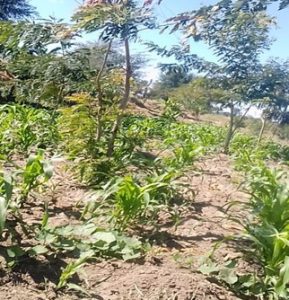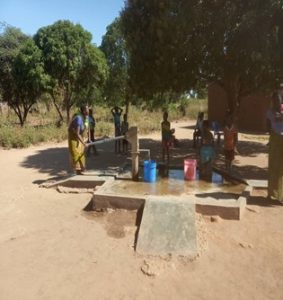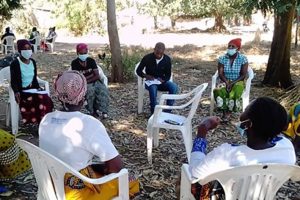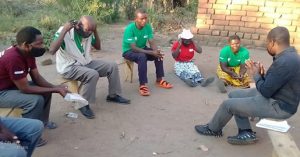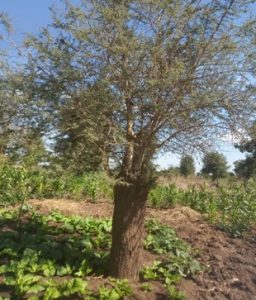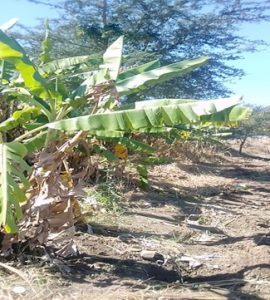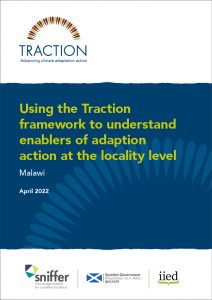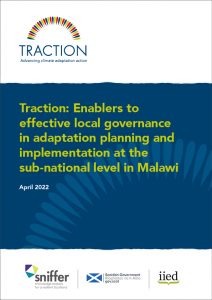Using Traction at a locality level in Malawi
Who used the Traction framework in Malawi? Describe the partnership and where they are in their adaptation journey
The Traction framework was used with communities and stakeholders who had been involved with the Trocaire and Scottish Government funded Climate Challenge Programme Malawi (CCPM) This programme focused on improving community resilience to the adverse effects of climate change by developing and implementing adaptation strategies to improve agricultural production and sustain rural livelihoods in Balaka, Chikwawa, Machinga and Zomba districts in the Southern Region of Malawi.
The Traction framework was applied in 2021 by Evidence for Development Consulting, a Malawi-based consultancy team, to better understand “what has enabled or inhibited adaptation progress?” as a part of reflecting on the work of the CCPM. Embedded in this was the intention to explore with participants issues of local governance and adaptation in relation to:
- water management (including access to water, drought, and flood risk management)
- decision making processes
- inclusion, justice, and gender equality.
Why did partners in Malawi think that using the Traction framework would be helpful for them?
Sniffer proposed using the Traction framework with Trocaire and Evidence for Development Consulting, initially as a basis for CCPM project analysis and reflection to understand: how connecting levels, sectors and groups have contributed to enablers of and inhibitors to adaptation progress; and what are the priority enablers to consider in forward planning. The structure of the framework created a way to discuss what is enabling adaptation progress across the five key enablers: visioning and leadership, governance, gathering and use of information, cooperation, and justice.
What were the key stages of the Traction process – what happened?
The following five stages took place from May 2021 to October 2021.
1. Endorsement: Sniffer shared an outline of the framework, and explained its use and purpose to Trocaire and Evidence for Development Consulting. This was endorsed by the group, who agreed that a research framework be developed for field implementation
2. Co-design: Sniffer, Trocaire and Evidence for Development Consulting created a set of questions to explore with participants on local governance and adaptation in relation to:
- water management (including access to water, drought, and flood risk management)
- decision making processes
- inclusion, justice, and gender equality.
These were developed under the five enablers within the Traction framework. The questions were tested and refined with members of a sample of community groups and district government officials, to make sure that they were appropriate for the local context. It was crucial that the questions created space for people to discuss what was important for them and their place.
3. Conversations: These questions were then used to guide a series of face-to-face focus group discussions and individual interviews in sixteen villages in Balaka, Chikwawa, Machinga and Zomba districts in the Southern Region of Malawi. This involved men and women, older and younger people, district government officers from a broad range of sectors, water management, local planning, agriculture, disaster management as well as community representatives of women’s farmers and water managers groups. These conversations were led by Evidence for Development Consulting. Crucially these discussions were structured to allow a range of voices to be heard, with different sessions for farmers, women’s and water users’ groups, local authority representatives, and local leaders
4. Validation: From the recordings and transcripts of the focus group discussions and interviews, Evidence for Development Consulting pulled out key messages, which were then shared with the participants for further feedback, reflection and validation.
5. Interpretation: The key messages were then reviewed by Sniffer and Evidence for Development Consulting who applied the Traction framework to explore what enabled adaptation progress across the five key enablers:– based on field research. Findings were discussed between Sniffer, Trocaire and Evidence for Development Consulting to validate conclusions.
What did the group learn from applying the Traction framework?
The Traction framework was seen as an opportunity to understand what important features of effective local governance for adaptation through deep community insights and locally driven approaches are. Based on learning with communities and local Government officials in Balaka, Chikwawa, Machinga and Zomba districts in the Southern Region of Malawi, this included:
The Malawi decentralized governance system is an enabler to adaptation. Local structures have been put in place providing an avenue for communities’ views to feed into decision making at both district and national levels. Adaptation action is integrated across sectors and scales with coherence or alignment between policies relating to livelihoods, agriculture, poverty reduction, disaster and climate change programs cascaded from national level through local Government programs through multi-sectoral and stakeholder structures. National to local policy coherence and a close integration between CCMP and other policies through vertical and horizontal coherence at the district level.
Multi-stakeholder governance structures facilitated by the District Executive Committee (DEC) and sub-committees have provided an important enabler to adaptation. District level deliberations have contributed to national policy making, for example, the inclusion of small livestock into the Affordable Input Program. Development of different district level plans such as district development plans, multi-hazard plans, water development or forestry plans follow a consultative multi-stakeholder process and DEC hold review meetings at district level outlining the impact of climate change or potential disasters on communities and local groups in a district to coordinate strategies, solutions and providing innovation through needs-based planning. Governance structures are supported through an upsurge of evidence from the local level, which inform higher level decision making for influencing policy, planning and resilience action. Needs based planning through tools such as the Participatory Vulnerability Capacity Assessment (PVCA) which offer innovation in knowledge flow and contribute to multi-stakeholder and multi-sector planning from district councils to national level.
At district level, information on the impact of climate change is formalized through DEC multi-stakeholder and multi-sector review meetings. These gatherings are attended by both government and non-state actors. Districts have devised ways of disseminating climate change related messages through two non-traditional methods, Short Message Services (SMS) through cell phones and the use of agriculture extension agents from district to the local levels. Theimportance of locally relevant information, presented in many ways and media throughout communities, and based on the different needs, and contexts is key. Scientific messages disseminated are translated into local language, making messages more user-friendly to people in communities. Implementation of climate change related policies in local communities are stakeholder inclusive. Decentralization demands that grassroots communities be consulted in the development phase of adaptation actions. NGOs advocacy on women’s leadership, deliberate approaches by district stakeholders to include women in civil protection committees, and NGOs playing a critical role in building local capacities and empowering community groups have contributed to enabling adaptation through decentralization.
Malawi’s climate change management policy recognizes that women and girls are disproportionately affected by climate change and are more vulnerable to its impacts. Women representative posts are established to ensure that women’s specific issues are integrated into various adaptation initiatives. Offering support to women through skills and confidence development, inspiration through leadership, and economic empowerment have been key. Victims of disasters have in the past been involved in overall assessment of damage by the Village Civil Protection Committees. Women`s involvement is enabled through their own satisfaction in contributing to community service and provision of training from different organizations, inspiration from fellow women working for partner organizations and role modelling in advocating women’s leadership in development.
Whilst enablers have supported adaptation planning and implementation, inhibitors are also identified. Vertical integration was impacted by limited financial and human resources, for example, where local capacities and resources were limited, impacting development and implementation of contingency plans by the local structures. Women`s participation was affected by transport and mobility, as well as social and cultural context, norms, and expectations. Lack of mechanisms in districts to formalize multi-sectoral exchange and learning beyond the review meetings at the district were also identified as inhibitors. False promises and politicization of adaptation measures by people vying for political positions as a means of amassing votes, or perceived lack of transparency in financial utilization and management of non-governmental organizations’ projects limited adaptation progress.
How are the findings from the Traction process being used to shape next steps?
The Traction process has offered insights for partners on important features to further enable adaptation at the local level to inform strategy development, investment and capacity development. In addition, Traction offered a tool to understand adaptation efforts that have already been implemented and how various actors can contribute to planning and implementation.
What did the Malawi district experience reveal about how the Traction framework and process could be improved in the future?
The Traction framework has offered opportunities to help stakeholders in Malawi. However, it was recognized that it will be important to make the framework more accessible and help future users apply the framework with some practical tools and easier, simpler language. In addition, helping to communicate the inter-relationships between enablers will support future users.
Who could learn from how the Traction framework has been used in districts in Malawi?
The learning from the four districts relevant throughout Malawi but also more generally. To take learning forwards in Malawi, it is recommended to:
- Share learning with national organizations working on climate action including key government staff from the Ministry of Finance, environmental department, metrological services, agriculture, gender, National Civil Society Networks and donors
- Enable district to district learning and exchange
- Carry out national policy analysis to identify complementarity and differences that may affect adaptation planning and implementation.
